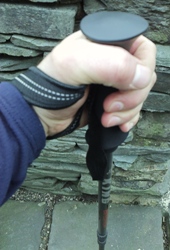 |
| How to Use Trekking Poles during the trekking |
Trekking poles (also known as hiking poles, hiking sticks or walking poles) are a common hiking
accessory used to assist walkers with their rhythm and provide stability on rough terrain.
During the trekking if you use Trekking Poles we have some advantages
- Protect knees, especially when walking down steep hills
- Improve your power and endurance when walking uphill
- Aid balance on uneven trails
- Improve posture, making walkers more upright as they walk and in turn this can help breathing
- Increase speed, especially going downhill
- Provide extra stability
- Reduce fatigue and improve endurance
- Burn more calories by providing an upper body work out as well as a legs workout
- Strengthen muscles that support the spine.
- Build muscles in arms, shoulders and neck.
- A useful extra (or substitute) pole for a tent or tarp shelter.
- To test the depth of streams or snow.
- Photo “monopod” (like a tripod). Some poles a camera attachment.
- Crossing the water and river
How to Use Trekking Poles
Trekking poles provide experienced bushwalkers with a valuable aid to stability when negotiating steep descents and obstacles (creek crossings etc). Poles might engage the ground to the front, side or behind - together as a pair, or one at a time. Specific pole techniques in this mode are limited only by individual experience and imagination.
Poles for health & fitness
When poles aren't required for stability in the difficult sections, they can be engaged to help the walking and to contribute to improved health and fitness. These techniques are much more specific and they need some explanation.
Two poles or one?
Bushwalkers who use just one pole for some added stability get only that one benefit. Poles are used as a pair to receive the full health and fitness benefits. The new generation poles are very much lighter, quicker/easier to operate and much more compact when stowed. The old reasons for using just one pole no longer apply.
Hand Position - Important!
It's easy to overlook the wrist strap, but it's a very important part of the trekking pole. The strap takes all the weight and allows the hand to relax.
Step 1
With the pole in the normal vertical position and the wrist strap hanging normally from the grip (brand name out and untwisted), enter the cupped hand into the wrist strap loop from underneath.
Step 2
Pass the hand right through until the wrist strap loop makes contact with the start of the forearm.
Step 3
Now open the hand and bring it down to surround the grip normally. When you push down on the pole, you will feel the wrist strap supporting the lower edge of the hand close to the wrist.
Step 4
Adjust the length of the wrist strap to position the hand comfortably at the grip until the wrist strap feels supportive. The strap takes the load via the wrist/arm - not the hand grip via the fingers/hand.
Step 5
Relax the hand. Just bring thumb and forefinger tips together to lightly surround the grip. This practice helps avoid the common mistake of grasping the grip too firmly which can cause hand fatigue and interfere with good pole technique.
Walking - correct technique
Start Position
With wrist straps engaged and lightly holding the grips, drop arms down by your sides allowing the pole tips to rest on the ground behind you.
Start Walking
 |
| Trekking in Nepal |
Arm Swing
We all swing our arms in a natural balancing rhythm that doesn’t change for pole walking. Allow your arms to develop their normal swing rhythm with the poles still dragging along behind.
Load Up
Now begin to engage the poles by allowing the pole tips to dig in as they come forward and by pushing slightly back as each arm begins to swing backwards. Continue to maintain your natural rhythm. Gradually increase the push on the back swing until you feel the poles propelling you forward.
Don’t load up excessively - just a little weight on each back swing will add to the effort.
If, at any time, you become overly conscious of the poles or feel slightly uncoordinated, just return to dragging the poles along behind you without loading them up. When the rhythm is right, start loading up again. When you are walking with loaded up poles to your natural rhythm, you have the technique - it's that simple.
Some Picture How to use Trekking Poles



1 comment:
Great tutorial! Thanks! I was looking for tutorials to help me get the idea how to use hiking poles propperly, and yours definitely helped. I have also found one that deals with the same topic, but also explains some of the benefits of using hiking poles and a few different techniques, you can check it out here: http://hikingmastery.com/basics/how-to-use-walking-poles.html
Post a Comment